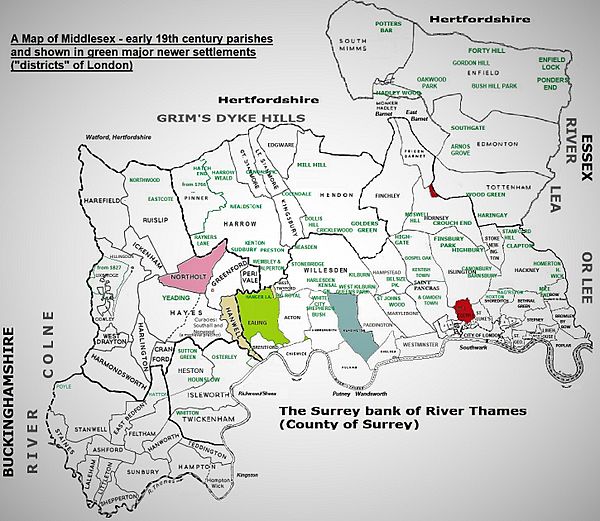Ossulstone facts for kids
| Ossulstone | |
| Ossulstone Hundred in Middlesex.svg | |
| Geography | |
| Status | hundred |
| 1831 area | 47,950 acres (194.0 km2) |
| History | |
| Created | in antiquity |
Quick facts for kids Demography |
|
|---|---|
| 1831 population | 1,008,441 |
| 1881 population | 2,205,806 |
| Subdivisions | |
| Type | Divisions / liberties |
Ossulstone was a very old part of Middlesex, a historic county in England. It was like a big district or area. It covered about a quarter of Middlesex and was the most city-like part. Ossulstone surrounded the City of London but didn't include it.
Today, this area is completely covered by the growth of London. It now includes seven London Boroughs north of the River Thames. It also covers parts of Ealing, Brent, Barnet, and Haringey.
Contents
The Story of Ossulstone
What's in a Name?
The name "Ossulstone" comes from "Oswald's Stone." This was an old, unmarked stone. It stood in Tyburn, which is now near Marble Arch in London. The stone was buried in 1819 but dug up later. People thought it was very important for history. It disappeared in 1869 and hasn't been seen since.
Where Did They Meet?
A "hundred" was a type of old local government area. Each hundred had a "hundred court." This was like a local meeting place or court. The Ossulstone court first met at Oswald's Stone. Later, it moved to Holborn, closer to London's legal area. By the 19th century, the court met in a building near Red Lion Square.
Ossulstone was always the biggest of the six hundreds in Middlesex. From early times, it had more than 20 parishes. Parishes were like small local areas. It also had many special areas called "liberties." These areas had their own rules and freedoms.
Ossulstone's Borders
Ossulstone was a large area. It bordered other hundreds like Elthorne and Gore to the west and north-west. To the north-east, it bordered Edmonton hundred. To the east, it bordered Becontree hundred in Essex.
Many of its southern borders were along the River Thames. South of the Thames were other hundreds in Kent and Surrey. The only bridge to cross the Thames below Kingston was London Bridge. However, Ossulstone did not include the City of London, where that bridge was located.
Battles in Ossulstone
The edges of Ossulstone were important for military reasons. All three of Middlesex's known battles happened here:
Battle of Brentford (1016)
This was a small victory for Edmund II of England, also known as "Ironside." He fought against the Danes in this battle.
Battle of Barnet (1471)
This battle happened during the Wars of the Roses. It was a very important fight. Along with another battle in Gloucestershire, it helped Edward IV of England get his throne back.
Battle of Brentford (1642)
This was a small battle during the English Civil War. It was a victory for the Royalist forces, led by Prince Rupert. After this battle, the fighting stopped for the winter. The Royalists retreated to Oxford.
How Ossulstone Was Divided
In the 1600s, Ossulstone was split into five smaller areas called divisions. Each division had its own court. This helped manage the area better.
One of these divisions was the Tower Division, also known as Tower Hamlets. This division had extra responsibilities. It had its own lord-lieutenant, who was like a local military leader. This meant it handled military duties usually done by the whole county.
Here are the five divisions of Ossulstone:
| Division | Main Parishes and Areas |
|---|---|
| Kensington | Kensington, Chelsea, Fulham, Hammersmith, Ealing, Acton, Willesden, and Brentford. It also included the smaller area of West Twyford. |
| Holborn | Marylebone, Paddington, St Pancras, and Hampstead. It also had smaller areas like St Giles in the Fields and parts of Westminster. |
| Finsbury | Islington, Finchley, Hornsey, Friern Barnet, and Stoke Newington. Smaller areas included St Lukes and Clerkenwell. |
| Tower Hamlets | Hackney, Shoreditch, Bethnal Green, Stepney, Bow, Mile End Old Town, Poplar, and Bromley-by-Bow. It also included many smaller areas like Whitechapel and Wapping. |
| Westminster | This division had smaller parishes that were still quite large compared to those in the City of London. These included St Margaret and St John, St Anne (Soho), St Clement Danes, and St George Hanover Square (Mayfair and Belgravia). |


